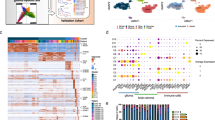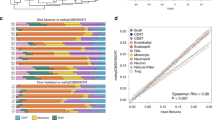Abstract
There is little known regarding the immune infiltrate present in pediatric brain tumors and how this compares to what is known about histologically similar adult tumors and its correlation with survival. Here, we provide a descriptive analysis of the immune infiltrate of 22 fresh pediatric brain tumor tissue samples of mixed diagnoses and 40 peripheral blood samples. Samples were analyzed using a flow cytometry panel containing markers for immune cell subtypes, costimulatory markers, inhibitory signals, and markers of activation. This was compared to the standard method of immunohistochemistry (IHC) for immune markers for 89 primary pediatric brain tumors. Both flow cytometry and IHC data did not correlate with the grade of tumor or mutational load and IHC data was not significantly associated with survival for either low grade or high grade gliomas. There is a trend towards a more immunosuppressive phenotype in higher grade tumors with more regulatory T cells present in these tumor types. Both PD1 and PDL1 were present in only a small percentage of the tumor infiltrate. T cell receptor sequencing revealed up to 10% clonality of T cells in tumor infiltrates and no significant difference in clonality between low and high grade gliomas. We have shown the immune infiltrate of pediatric brain tumors does not appear to correlate with grade or survival for a small sample of patients. Further research and larger studies are needed to fully understand the interaction of pediatric brain tumors and the immune system.





Similar content being viewed by others
References
Curtin SC, Miniño AM, Anderson RN (2016) Declines in cancer death rates among children and adolescents in the United States, 1999–2014. NCHS data brief, no 257. National Center for Health Statistics, Hyattsville
Neagu M. Reardon D (2015) An update on the role of immunotherapy and vaccine strategies for primary brain tumors. Curr Treat Options Oncol 16(11):54. https://doi.org/10.1007/s11864-015-0371-3
Yang I, Han S, Sughrue M, Tihan T, Parsa A (2011) Immune cell infiltrate differences in pilocytic astrocytoma and glioblastoma: evidence of distinct immunological microenvironments that reflect tumor biology. J Neurosurg 115:505–511. https://doi.org/10.3171/2011.4.JNS101172
Bienkowski M, Preusser M (2015) Prognostic role of tumor-infiltrating cells in brain tumors: literature review. Curr Opin Neurol 28(6):647–658. https://doi.org/10.1097/WCO.0000000000000251
Kmiecik J, Poli A, Brons N, Waha A, Eide G, Enger P, Zimmer J, Chekenya M (2013) Elevated CD3+ and CD8+ tumor-infiltrating immune cells correlate with prolonged survival in glioblastoma patients despite integrated immunosuppressive mechanisms in the tumor microenvironment and the systemic level. J NeuroImmunol 264:71–83. https://doi.org/10.1016/j.jneuroim.2013.08.013
Jacobs J, Idema A, Bol K, Grotenhuis A, Vries J, Wesseling P, Ademma G (2010) Prognostic significance and mechanism of Treg infiltration in human brain tumors. J Neuroimmunol 255:195–199. https://doi.org/10.1016/j.jneuroim.2010.05.020
Komohara Y, Horlad H, Fujiwara Y, Bai B, Nakagawa T, Suzu S, Nakamura H, Kuratsu J, Takeya M (2012) Importance of direct macrophage-tumor cell interaction on progression of human glioma. Cancer Sci 103(12):2165–2172. https://doi.org/10.1111/cas.12015
Donson M, Birks D, Schittone S, Kleinschmidt-DeMasters B, Sun D, Hemenway M, Handler M, Waziri A, Wang M, Foreman N (2012) Increased immune gene expression and immune cell infiltration in high grade astrocytoma distinguish long from short term survivors. J Immunol 189(4):1920–1927. https://doi.org/10.4049/jimmunol.1103373
Lohr J, Ratliff T, Huppertz A, Ge Y, Dictus C, Ahmadi R, Grau L, Hiroaka N, Eckstein V, Ecker R, Korff T, von Diemling A, Unterberg A, Beckhove P, Herold-Mende C (2011) Effector T cell infiltration positively impacts survival of glioblastoma patients and is impaired by tumor-derived TGF-beta. Clin Cancer Res 17(13):4296–4308. https://doi.org/10.1158/1078-0432.CCR-10-2557
Yang I, Tihan T, Han S, Wrensch M, Wiencke J, Sughrue M, Parsa A (2010) CD8+ T cell infiltrate in newly diagnosed glioblastoma associated with long term survival. J Clin Neurosci 17(11):1381–1385. https://doi.org/10.1016/j.jocn.2010.03.031
Prosniak M, Harshyne L, Andrews D, Kenyon L, Bedelbaeva K, Apanasovich T, Heber-Katz E, Cotzia P, Hooper D (2013) Glioma grade is associated with the accumulation and activity of cells bearing M2 monocyte markers. Clin Canc Res 19(14):3776–3786. https://doi.org/10.1158/1078-0432.CCR-12-1940
Berghoff A, Kiesel B, Widhalm G, Rajky O, Ricken G, Wohrer A, Dieckmann K, Filipits M, Brandsetter A, Weller M, Kurscheid S, Hegi M, Zielinksi C, Marosi C, Hainfellner J, Preusser M, Wick W (2015) Programmed cell death ligand 1 expression and tumor-infiltrating lymphocytes in glioblastoma. Neuro Oncol 17(8):1064–1075. https://doi.org/10.1093/neuonc/nou307
Rooney M, Shukla S, Wu C, Getz G, Hacohen N (2015) Molecular and genetic properties of tumors associated with local immune cytolytic activity. Cell 160:48–61. https://doi.org/10.1016/j.cell.2014.12.033
Van Allen E, Miao D, Schilling B, Shukla S, Blank C, Zimmer L, Sucker A, Hillen U, Guekes Foppen M, Goldinger S, Utikal J, Hassel J, Weide B, Kaehler K, Loquai C, Mohr P, Gutzmer P, Dummer R, Gabriel S, Wu C, Schadendorf D, Garraway L (2015) Genomic correlates of response to CTLA-4 blockade in metastatic melanoma. Science 350(6257):207–211
Rizvi N, Hellman M, Snyder A, Kvistborg P, Makarov V, Havel J, Lee W, Yuan J, Wong P, Ho T, Miller M, Rekhtman N, Moreira A, Ibrahim F, Bruggeman C, Gasmi B, Zappasodi R, Maeda Y, Sander C, Garon E, Merghoub T, Wolchok J, Schumacker T, Chan T (2015) Mutational landscape determines sensitivity to PD-1 blockade in non-small cell lung cancer. Science 348(6230):124–126. https://doi.org/10.1126/science.aaa1348
Lawrence M, Stojanov P, Polak P, Kryukov GV, Cibulskis K, Sivachenko A, Carter SL, Stewart C, Mermel CH, Roberts SA, Kiezun A, Hammerman PS, McKenna A, Drier Y, Zou L, Ramos AH, Pugh TJ, Stransky N, Helman E, Kim J, Sougnez C, Ambrogio L, Nickerson E, Shefler E, Cortes ML, Auclair D, Saksena G, Voet D, Noble M, DiCara D, Lin P, Lichetsein L, Heiman DI, Fennell T, Imielinski M, Hernandez B, Hodis E, Baca S, Dulak A, Lohr J, Landau D, Wu C, Melendez-Zajgla J, Hidalgo-Miranda A, Koren A, McCarroll S, Mora J, Lee R, Crompton B, Onofrio R, Parkin M, Winckler W, Ardlie K, Gabriel S, Roberts C, Biegel J, Stegmaier K, Bass A, Garraway L, Meyerson M, Golub T, Gordenin D, Sunyaev S, Lander E, Getz G (2013) Mutational heterogeneity in cancer and the search for new cancer-associated genes. Nature 499(7457):214–218. https://doi.org/10.1038/nature12213
Brown S, Warren R, Gibb E, Martin S, Spinelli J, Nelson B, Holt R (2015) Neo-antigens predicted by cancer genome meta-analysis correlate with increased patient survival. Genome Res 24(5):743–750. https://doi.org/10.1101/gr.165985.113
Griesinger A, Birks D, Donson A, Amani V, Hoffman L, Waziri A, Wang M, Handler M, Foreman N (2013) Characterization of distinct immunophenotypes across pediatric brain tumor types. J Immunol 191(9):4880–4888. https://doi.org/10.4049/jimmunol.1301966
Griesinger A, Donson A, Foreman N (2014) Immunotherapeutic implications of the immunophenotype of pediatric brain tumors. OncoImmunology 3(1):e27256. https://doi.org/10.4161/onci.27256
Koyama S, Akbay E, Li Y, Herter-Sprie G, Buckowski Z, Richards W, Gandhi L, Redig A, Rodig S, Asahina H, Jones R, Kulkami M, Kuraguchi M, Palakurthi S, Fecci P, Johnson B, Janne P, Engleman J, Gangadharan S, Costa D, Freeman G, Bueno R, Hodi F, Dranoff G, Wong K, Hammerman P (2016) Adaptive resistance to therapeutic PD-1 blockade is associated with upregulation of alternative immune checkpoints. Nat Commun 17(7):10501. https://doi.org/10.1038/ncomms10501
Du Z, Abedalthagafi M, Aizer A, McHenry A, Sun H, Bray MA, Viramontes O, Machaidze R, Brastianos P, Reardon D, Dunn I, Freeman G, Ligon K, Carpenter A, Alexander B, Agar N, Rodig S, Bradshaw E, Santagata S (2014) Increased PDL1 expression of the immune modulatory molecular PD-L1 (CD274) in anaplastic meningioma. Oncotarget 6(7):4704–4716. https://doi.org/10.18632/oncotarget.3082
Robins H, Campregher P, Srivastava S, Wacher A, Turtle C, Kahsai O, Riddell S, Warren E, Carlson C (2009) Comprehensive assessment of T-cell receptor β-chain diversity in αβ T cells. Blood 114(19):4099–4107. https://doi.org/10.1182/blood-2009-04-217604
Carlson C, Emerson S, Sherwood A, Desmarais C, Chung M, Parsons J, Steen M, LaMadrid-Herrmannsfeldt M, Williamson D, Livingston R, Wu E, Wood B, Rieder M, Robins H (2013) Using synthetic templates to design unbiased multiplex PCR assay. Nat Commun 4:2680. https://doi.org/10.1038/ncomms3680
Robins H, Desmarais C, Matthis J, Livingston R, Andriesen J, Reijonen H, Nepom G, Yee C, Cerosaletti K (2012) Ultra-sensitive detection of rare T cell clones. J Immunol Methods 375(1–2):14–19. https://doi.org/10.1016/j.jim.2011.09.001
Kirsch I, Vignali M, Robins H (2015) T cell-receptor profiling in cancer. Mol Oncol 9(10):2063–2070. https://doi.org/10.1016/j.molonc.2015.09.003
Ramkissoon SH, Bandopadhayay P, Hwang J, Ramkissoon LA, Greenwald NF, Schumacher SE, O’Rourke R, Pinches N, Ho P, Malkin H, Sinai C, Filbin M, Plant A, Bi WL, Chang MS, Yang E, Wright KD, Manley PE, Ducar M, Alexandrescu S, Lidov H, Delalle I, Goumnerova LC, Church AJ, Janeway KA, Harris MH, MacConnell LE, Folkerth RD, Lindeman NI, Stiles CD, Kieran MW, Ligon AH, Santagata S, Dubuc AM, Chi SN, Beroukhim R, Ligon KL (2017) Clinical targeted exome-based sequencing in combination with genome wide copy number profiling: precision medicine based analysis of 203 pediatric brain tumors. Neuro Oncol. https://doi.org/10.1093/neuonc/now294
Sholl LM, Do K, Shivdasani P, Cerami E, Dubuc AM, Kuo FC, Garcia EP, Jia Y, Davineni P, Abo RP, Pugh TJ, van Hummelen P, Thomer AR, Ducar M, Berger AH, Nishino M, Janeway KA, Church A, Harris M, Ritterhouse LL, Campbell JD, Rojas-Rudilla V, Ligon AH, Ramkissoon S, Cleary JM, Matulonis U, Oxnard GR, Chao R, Tassell V, Christensen J, Hahn WC, Kantoff PW, Kwiatkowski DJ, Johnson BE, Meyerson M, Garraway LA, Shapiro GI, Rollins BJ, Lindeman NI, MacConail LE (2016) Institutional implementation of clinical tumor profiling on an unselected cancer population. JCI Insight 1(19):e87062. https://doi.org/10.1172/jci.insight.87062
Fecci PE, Mitchell DA, Whitesides JF, Xie W, Friedman AH, Archer GE, Herndon JE 2nd, Bigner DD, Dranoff G, Sampson JH (2006) Increased regulatory T cell fraction amidst a diminished CD4 compartment explains cellular immune defects in patients with malignant glioma. Cancer Res 66(6):3294–3302. https://doi.org/10.1158/0008-5472CAN-05-3773
Ilie M, Hofman V, Dietel M, Soria JC, Hofman P (2016) Assessment of the PDL1 status by immunohistochemistry: challenges and perspectives for therapeutic strategies in lung cancer patients. Virchows Arch 468(5):511–525. https://doi.org/10.1007/s00428-016-1910-4
Sacher AG, Gandhi L (2016) Biomarkers for the clinical use of PD-1/PDL1 inhibitors in non-small cell lung cancer: a review. JAMA Oncol 2(9):1217–1222. https://doi.org/10.1001/jamaoncol.2016.0639
Funding
Research reported in this publication was supported by the National Cancer Institute of the National Institutes of Health under Award Number K12CA090354. The content is solely the responsibility of the authors and does not necessarily represent the official views of the National Institutes of Health. The portion of this project involving T cell receptor sequencing was supported by a Young Investigator Award supported by Adaptive Biotechnologies.
Author information
Authors and Affiliations
Corresponding author
Ethics declarations
Conflict of interest
Ashley Plant has no conflict of interest to disclose except that she is the recipient of the Young Investigator Award from Biotechnologies Incorporated in the amount of $5000 to support this project. Shohei Koyama has no conflict of interest to disclose. Claire Sinai has no conflict of interest to disclose. Isaac Solomon has no conflict of interest to disclose. Gabriel Griffin has no conflict of interest to disclose relevant to this project but does participate in consulting activities for Moderna Therapeutics. Keith Ligon has no conflict of interest to disclose related to the project. Pratiti Bandopadhayay has no conflict of interest to disclose. Rebecca Betensky has no conflict of interest to disclose. Ryan Emerson is an employee of Adaptive Biotechnologies Incorporated but, otherwise, has no conflict of interest to disclose. Glenn Dranoff became an employee of Novartis Institutes of Biomedical Research during the formation of this project but otherwise has no other conflict of interest to disclose. Mark W. Kieran has no conflict of interest to disclose related to this project. Jerome Ritz has no conflict of interest to disclose related to this project.
Ethical approval
No animals were used in this study. All procedures performed in studies involving human participants were in accordance with the ethical standards of the institutional and/or national research committee and with the 1964 Helsinki declaration and its later amendments or comparable ethical standards.
Informed consent
Informed consent was obtained from all individual participants included in the study prior to any tissue or blood sample collection.
Electronic supplementary material
Below is the link to the electronic supplementary material.
Rights and permissions
About this article
Cite this article
Plant, A.S., Koyama, S., Sinai, C. et al. Immunophenotyping of pediatric brain tumors: correlating immune infiltrate with histology, mutational load, and survival and assessing clonal T cell response. J Neurooncol 137, 269–278 (2018). https://doi.org/10.1007/s11060-017-2737-9
Received:
Accepted:
Published:
Issue Date:
DOI: https://doi.org/10.1007/s11060-017-2737-9




